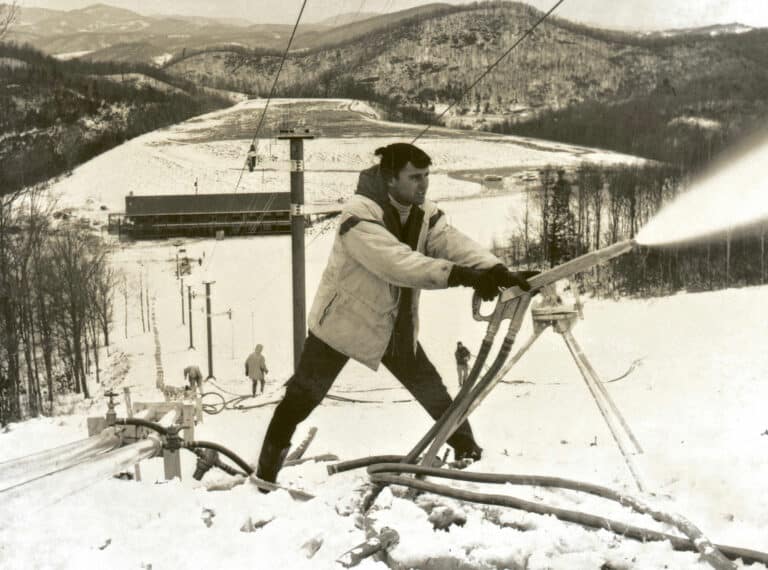Skate Skiing the Sods
The snow is hard and icy, and I’m flying through woods on the verge of out of control. The skate skis on my feet are super skinny, have almost no edges, and feel like ballet shoes.
I’m miles from a trailhead somewhere way back in the Dolly Sods Wilderness of eastern West Virginia, one of the coldest places in the Mid-Atlantic. The normally impenetrable bogs and marshes are frozen solid, and I’m alone and zooming across the sub-arctic landscape. It’s perfect conditions for skate skis.
 Skate ski gear is designed for smooth prepared tracks at Nordic ski areas. With extra long poles and stiff carbon boots, skate skiing gear is designed to be light, fast and aerobic. Unlike the traditional straight ahead, cross-country ski stride, skating is kind of like ice skating but on really long blades. Add a strong pole push with every other stride, and you have the fastest thing on snow that doesn’t involve ski lifts.
Skate ski gear is designed for smooth prepared tracks at Nordic ski areas. With extra long poles and stiff carbon boots, skate skiing gear is designed to be light, fast and aerobic. Unlike the traditional straight ahead, cross-country ski stride, skating is kind of like ice skating but on really long blades. Add a strong pole push with every other stride, and you have the fastest thing on snow that doesn’t involve ski lifts.
In the last fifteen years, skate skiing has taken off as the fastest growing new ski sport. Even the smallest cross-country centers have skate lanes. It takes awhile to learn the technique, but once mastered, it works the entire body without the pounding of downhill skiing.
I enjoy flying around well-groomed skate lanes at a Nordic center with pleasing terrain. But where it’s really at for me is taking it out of bounds. Skating involves staying on top of the snow, hence the need for groomed surfaces on skate specific lanes. The skis are so light and with such negligible edges that even an inch or so of soft is enough to bog you down and trip you up. So conditions have to be just right to leave the skate lanes and head off into the wilderness. Fortunately for skiers who are stuck in the mid-Atlantic during winter, the milder weather and frequent freeze-thaw cycles actually produce some of the best backcountry skating in the country. Warm temps followed by a freeze will often set up a hard, fast crusty surface perfect for backcountry exploration of otherwise inaccessible places at breakneck speeds.
Dolly Sods is the highest plateau of its type east of the Mississippi, a rolling tundra-like terrain that makes up part of the Eastern Continental Divide. At an altitude around 4,000 feet, it creates a rain shadow to the east and grabs most of the lake effect snowstorms. Last winter, the Sods recorded more than 250 inches of snow. It’s rocky and boggy, with numerous marshy wetlands and small streams choked with impenetrable laurel thickets.
Heading along the exposed ridge trail above Canaan Valley, I’m pummeled by the strong, cold westerly breeze that leaves barely enough snow coverage to avoid frozen dirt and rocks. I stagger into a wind shadow of red spruce where the snow has piled up, and the fun begins. The snow is deep and hard with a slightly breakable crust, and I quickly find my rhythm. It’s 3D ice-skating, the same diagonal strides and skating speeds, but with obstacles and lots of up and down. I’m flying through a stunning wintry landscape: skate, skate, double pole, skate, skate, double pole. I get into rollercoaster groove, using my downhill speed to rocket me back uphill with minimum effort. There’s not a lot of edge control, so you have to pick your angles wisely, dodging trees, rocks, and other obstacles while keeping up a steady flow.
Putting it all together properly with well-placed kicks and turns becomes an effortless Zen-like experience. The skis are so narrow that traditional ski turns require skill and strength. Miss one turn at speed and you’re quickly out of control. You haven’t skated until you’ve clipped a mountain laurel at high speed and ended up pounding into a tangled mess of gear that can take awhile to unwind. And hard snow hurts.
But sometimes at dusk, when the winds calm and the sky is glowing with leftover sunset, and I’m flying across this surreal frozen landscape, it’s like skiing in a dream. •
Whitegrass Nordic Center & Café
Canaan Valley, West Virginia
304-866-4114 / whitegrass.com
Laurel Ridge State Park X-C Area
Rockwood, Pennsylvania
724-455-7303







